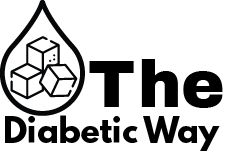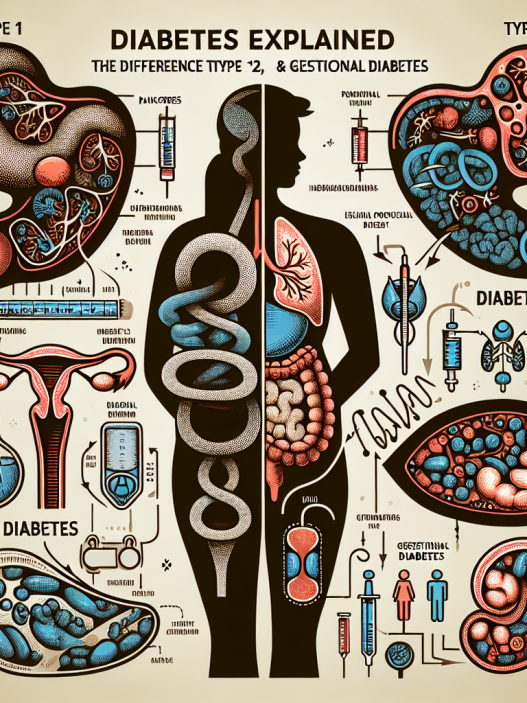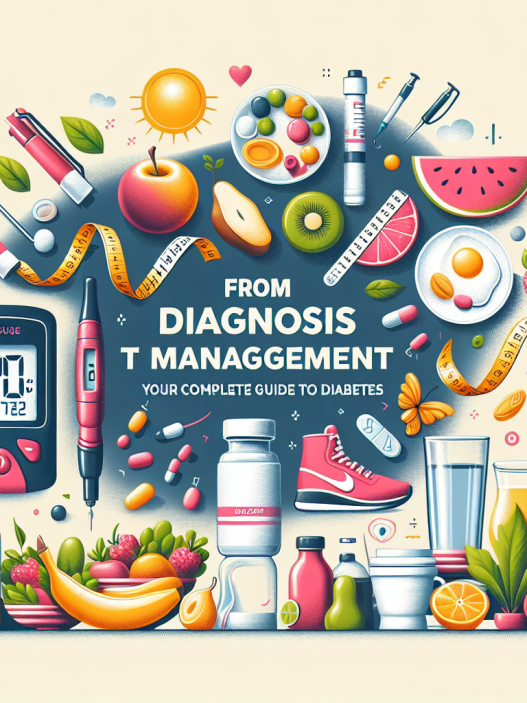[ad_1]
Diabetes is a chronic health condition that affects millions of people worldwide, characterized by high blood sugar levels. This comprehensive guide will explore the different types of diabetes, the symptoms to watch for, and effective management strategies to live a healthy life. Whether you’re newly diagnosed or seeking to understand diabetes better, this guide serves to educate and empower you with valuable insights into managing this condition.
Understanding Diabetes: The Basics of Blood Sugar Regulation
Diabetes is a complex disease that centers around the body’s inability to properly produce or utilize insulin, a hormone produced by the pancreas that regulates blood sugar levels. When insulin is either insufficient or ineffective, glucose builds up in the bloodstream, leading to a range of health issues. Understanding the basics of diabetes is crucial for recognizing its symptoms and managing the condition effectively.
There are two primary types of diabetes: Type 1 and Type 2. Type 1 diabetes often develops during childhood or adolescence and is characterized by the body’s immune system attacking insulin-producing cells in the pancreas. This type of diabetes requires lifelong insulin therapy and diligent monitoring of blood sugar levels. In contrast, Type 2 diabetes is more prevalent and typically develops in adults, although it is increasingly being diagnosed in children and adolescents due to rising obesity rates. This type occurs when the body becomes resistant to insulin or does not produce enough insulin to maintain normal glucose levels.
Types of Diabetes: A Closer Look at Your Condition
Diabetes is broadly categorized into several types, each with distinct pathways and implications for treatment. Let’s delve deeper into these classifications, beginning with Type 1 and Type 2 diabetes.
Type 1 Diabetes: An Immune System Attack
Type 1 diabetes accounts for about 5-10% of all diabetes cases. It is an autoimmune disorder where the immune system mistakenly attacks and destroys the insulin-producing beta cells in the pancreas. The onset of Type 1 diabetes is usually abrupt, with symptoms such as excessive thirst, frequent urination, extreme hunger, and fatigue appearing suddenly. Since the body produces little to no insulin, individuals with Type 1 diabetes must rely on external insulin sources through injections or an insulin pump, making consistent blood sugar monitoring essential.
Type 2 Diabetes: The Lifestyle Connection
Type 2 diabetes is much more common, affecting approximately 90-95% of all people with diabetes. It typically develops later in life, although increasing incidences in younger populations are being reported. The key factors include genetic predisposition and lifestyle choices such as poor diet, physical inactivity, and obesity. In this type, the body does not use insulin effectively—a phenomenon known as insulin resistance—or does not produce enough insulin to maintain glucose homeostasis. Management of Type 2 diabetes often begins with lifestyle modifications, including diet and exercise, before progressing to medications and, in some cases, insulin therapy.
Gestational Diabetes: Unique to Pregnancy
Gestational diabetes is a temporary form of diabetes that occurs during pregnancy. It usually develops around the 24th week of pregnancy and affects how the body processes glucose. Although gestational diabetes typically resolves after childbirth, it can pose risks to both the mother and the baby if not managed properly. Women diagnosed with gestational diabetes have a heightened risk of developing Type 2 diabetes later in life, indicating the need for ongoing monitoring and lifestyle adjustments postpartum.
Other Specific Types of Diabetes
There are also other, less common types of diabetes, including Monogenic Diabetes, which results from a change in a single gene, and Secondary Diabetes, which occurs due to another medical condition or medication that disrupts insulin production or action. These conditions, while rare, underscore the complexity of diabetes as a disease and highlight the importance of a tailored treatment approach.
Recognizing the Symptoms of Diabetes: Early Detection Saves Lives
Awareness of the symptoms of diabetes is crucial for early diagnosis and effective disease management. Recognizing these symptoms can help individuals seek medical advice promptly, potentially preventing serious complications.
Common Symptoms to Watch For
Some of the most prevalent symptoms of diabetes include increased thirst and hunger, frequent urination, fatigue, blurred vision, and slow healing of wounds. Individuals may also experience unexpected weight loss, particularly in Type 1 diabetes, where the body breaks down fat and tissue for energy due to insufficient insulin. These symptoms may vary depending on the type and duration of the disease, making it important to consult a healthcare provider if they arise.
Managing Symptoms Through Lifestyle Changes
In addition to medication, lifestyle changes can significantly alleviate diabetes symptoms and improve overall health. Maintaining a balanced diet low in refined sugars and high in fiber, regular physical activity, and managing stress effectively can all contribute to better blood sugar control. It’s essential to engage in routine check-ups to monitor blood glucose levels, as consistent tracking allows for adjustments in treatment before complications arise.
The Importance of Regular Check-Ups
Regular medical check-ups play a vital role in diabetes management. Through routine lab tests, healthcare providers can assess blood glucose levels, kidney function, and other critical health markers. Monitoring these factors helps in adjusting treatment plans, promoting preventive measures, and managing any potential complications that may arise due to chronic elevations in blood sugar levels.
Complications of Diabetes: Understanding the Risks
Uncontrolled diabetes can lead to serious and potentially life-threatening complications. Understanding these risks is paramount for anyone diagnosed with the disease.
Short-Term Complications of Diabetes
Short-term complications, such as diabetic ketoacidosis (more prevalent in Type 1 diabetes) and hyperglycemic hyperosmolar state (common in Type 2 diabetes), can occur if blood sugar levels become dangerously high. Diabetic ketoacidosis can be life-threatening and requires immediate medical attention, presenting with symptoms of nausea, vomiting, fruity breath, and abdominal pain. Similarly, hyperglycemic hyperosmolar state may lead to severe dehydration, altered consciousness, or coma.
Long-Term Complications: The Silent Dangers
Long-term complications develop gradually over time and can severely impact the quality of life. They include cardiovascular diseases, neuropathy (nerve damage), nephropathy (kidney damage), retinopathy (eye damage), and foot complications that can lead to amputation. These conditions arise primarily due to prolonged high blood sugar levels, emphasizing the importance of effective blood glucose management.
Preventive Measures: Taking Charge of Your Health
Fortunately, many long-term complications of diabetes can be prevented or delayed with effective management strategies. Maintaining stable blood sugar levels through a balanced diet, regular exercise, and consistent medication use can significantly reduce the risk. Regular screenings for complications—including eye exams, foot checks, and cardiovascular assessments—are critical components of successful diabetes management.
Effective Management Strategies for Diabetes: Empowering Yourself
Managing diabetes requires a comprehensive approach that integrates medical treatment, lifestyle modifications, and educational resources.
Dietary Choices: Food as Medicine
Nutrition plays a vital role in diabetes management. A well-planned diet focusing on whole grains, lean proteins, healthy fats, fruits, and vegetables can stabilize blood sugar levels. The carbohydrate counting method is often useful for individuals with diabetes, allowing them to monitor and manage carbohydrate intake effectively. Additionally, working with a registered dietitian can provide personalized meal plans and dietary guidelines based on individual health goals.
Physical Activity: Moving Toward Better Health
Regular physical activity is crucial for all individuals, but particularly for those with diabetes. Exercise helps improve insulin sensitivity, aids in weight management, and promotes overall cardiovascular health. The American Diabetes Association recommends at least 150 minutes of moderate-intensity aerobic activity each week, combined with muscle-strengthening activities on two or more days. Finding enjoyable activities can make exercise a manageable and rewarding part of daily life.
Medication Management: Working with Your Healthcare Team
For some individuals with diabetes, lifestyle changes alone may not be sufficient to control blood sugar levels. Various medications, including oral agents and insulin, may be necessary. It’s essential to work closely with a healthcare team to determine the most effective medications based on individual needs. Regular follow-ups can assist in monitoring treatment efficacy and making necessary adjustments to the diabetes management plan.
Technological Advances in Diabetes Management: Embracing Innovation
With advancements in technology, managing diabetes has become more effective and user-friendly.
Continuous Glucose Monitors (CGMs)
Continuous Glucose Monitors (CGMs) offer real-time blood glucose readings, providing valuable insights into blood sugar trends throughout the day. This information can help individuals make immediate adjustments to their diet or activity level, ultimately leading to better glycemic control. These devices also alert users when blood sugar levels are too high or too low, providing an additional layer of safety and management.
Insulin Pumps: Transforming Insulin Delivery
Insulin pumps provide a continuous supply of insulin, allowing for more precise control over blood glucose levels compared to traditional insulin injections. With programmable settings to deliver varying doses of insulin throughout the day, they adapt to the body’s needs more effectively. These devices improve the quality of life for many individuals with diabetes, reducing the burden of frequent injections.
Mobile Apps: Managing Your Diabetes at Your Fingertips
A plethora of mobile applications are now available to assist individuals with diabetes in tracking their food intake, medication schedules, blood sugar levels, and physical activity. These tools can foster accountability and empower users to take charge of their health in real-time. Additionally, many apps offer access to online communities and resources, allowing users to connect with others for support and motivation.
Living with Diabetes: Support and Resources for a Healthier Life
Living with diabetes can be challenging, but countless resources and support systems are available to help individuals navigate their journey.
Building a Support Network
Connecting with friends, family, and healthcare providers creates a robust support network. Open conversations about the challenges of living with diabetes can foster understanding and encouragement within personal relationships. Diabetes education programs and workshops also provide valuable resources and a sense of community among those sharing similar experiences.
Educational Resources: Knowledge is Power
Numerous organizations, such as the American Diabetes Association and Diabetes UK, offer extensive educational resources, including articles, webinars, and community events. These resources can empower individuals with diabetes, helping them stay informed about the latest research, treatment options, and management strategies. Staying educated on diabetes helps individuals make informed decisions about their health.
Self-Care and Mental Health: Prioritizing Your Well-Being
Living with diabetes can lead to emotional stress, anxiety, and depression, making it vital to prioritize mental health. Engaging in self-care practices like mindfulness, therapy, or support groups can help individuals cope with the emotional aspects of living with diabetes. Mental well-being is a form of self-care that often goes overlooked but is crucial for overall quality of life.
In conclusion, understanding diabetes is pivotal for effectively managing this chronic condition. By recognizing the different types, symptoms, and effective management strategies, individuals can take charge of their health and work towards a fulfilling life. Whether it involves dietary changes, exercise, monitoring blood sugar levels, or seeking support, each step can lead to significant improvements in managing diabetes and enhancing overall wellness. Don’t hesitate to reach out to health professionals and your support network as you embark on this journey towards better health. Together, we can navigate the complexities of diabetes, empowering each other to live our best lives.
[ad_2]






















